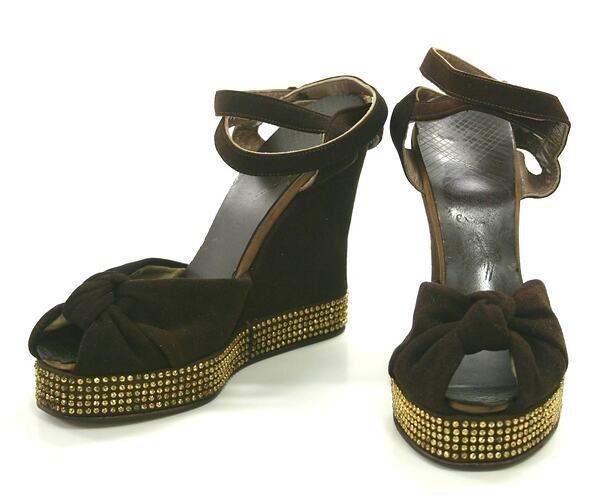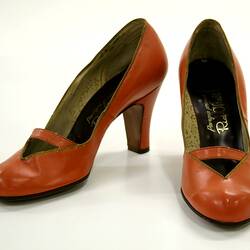Summary
Pair of brown suede shoes with ankle straps and gold studs around the sole. Exaggerated wedge heel. Made in the late 1940s to 1950s by Paragon.
Paragon Shoes Pty Ltd was one of the most significant 20th century Australian shoe retailers, and at one time was the largest manufacturer of high quality of women's shoes in Australia. Its factory was located in Melbourne, and its shoes were sold throughout Australia and New Zealand.
According to Caroline Cox in Vintage Shoes (2008, pp. 76-80), the wedge was invented as a practical response to sanction-led shortages in Italy during the Italo-Ethiopian war. Mussolini invaded Ethopia in 1935, and the League of Nations imposed sanctions against Italy. Florence-based shoemaker Salvatore Ferragamo found it difficult to find adequate quality steel for making shoe arches. In 1936, in desperation, he invented a heel that was completely filled in, made of layers of Scandanavian cork. The wedge became popular during war-time, when women needed a high heel for glamour but a sturdy sole to walk in when transport shortages were common. It was also a cheap shoe to make, with inexpensive materials such as plaited raffia, dyed straw, grass and cellophane used.
Physical Description
Pair of shoes made from brown suede, with gold-studded 'elevator' soles. Exaggerated wedge heel. Shoe features a knotted front, an open toe and back, and is secured with cross-over straps around ankle, which is fastened with a buckle. Five rows of small gold studs on base of platform. Leather soles.
Significance
The Paragon Shoe Collection comprises over 90 objects, including pairs of shoes and single shoes, point-of-sale materials and promotional materials such as business cards and an umbrella bearing the company name. The Collection documents the business and products of Paragon Shoes Pty Ltd, one of the most significant 20th century Australian shoe retailers, and at one time the largest manufacturer of high quality of women's shoes in Australia. Its factory was located in Melbourne, and its shoes were sold throughout Australia and New Zealand.
The collection was largely donated by a member of the Davison family, which ran the Paragon business for most of the 20th century. It documents the changing designs of Australian women's footwear, from the 1910s to the 1980s. It illustrates the development of new shoe styles, from sample shoes bought overseas to shoes that went into production and were worn by Australian women. The collection is complemented by an archive held at the State Library of Victoria, including company records, shoe design sketch books and further point-of-sale material.
More Information
-
Collection Names
-
Collecting Areas
-
Acquisition Information
Donation from Mrs Diana Gaze, Mrs Diana Gaze, 26 Oct 2005
-
Manufacturer
Paragon Shoes, Melbourne, Greater Melbourne, Victoria, Australia, 1940-1949
Date is probably late 1940s, but wedge style started in 1936. -
Inscriptions
Sticker attached to base: "Property of Paragon"
-
Classification
-
Category
-
Discipline
-
Type of item
-
Overall Dimensions
20.7 cm (Length), 7.8 cm (Width), 15 cm (Height)
Width is both shoes combined.
-
References
Howard, G., 2004. Lex Davison: Larger Than Life'. Turton & Armstrong, Sydney. Copies of several newspaper articles about Paragon from the early 1920s were included with the donation. The State Library of Victoria holds an archive relating to the Paragon business, containing receipt books, account books, advertising, clippings, sample book, sketches, photographs and a poster - MS 13570. The content dates range circa 1928-1988. An additional archive, PA 01/05, ranges 1940s-1980s.
-
Keywords
Footwear Industry, Manufacturing, Making History - Paragon Shoes

